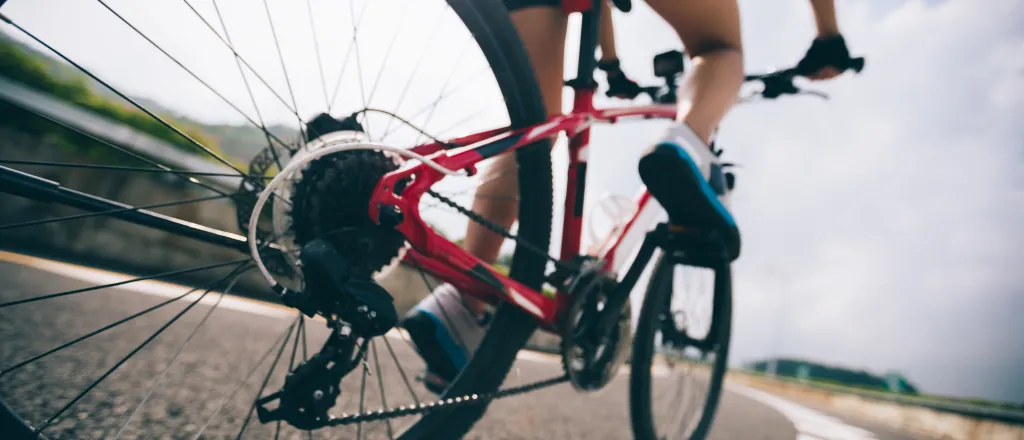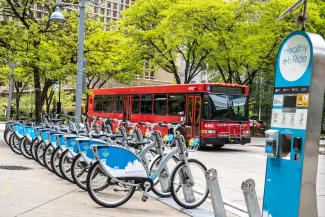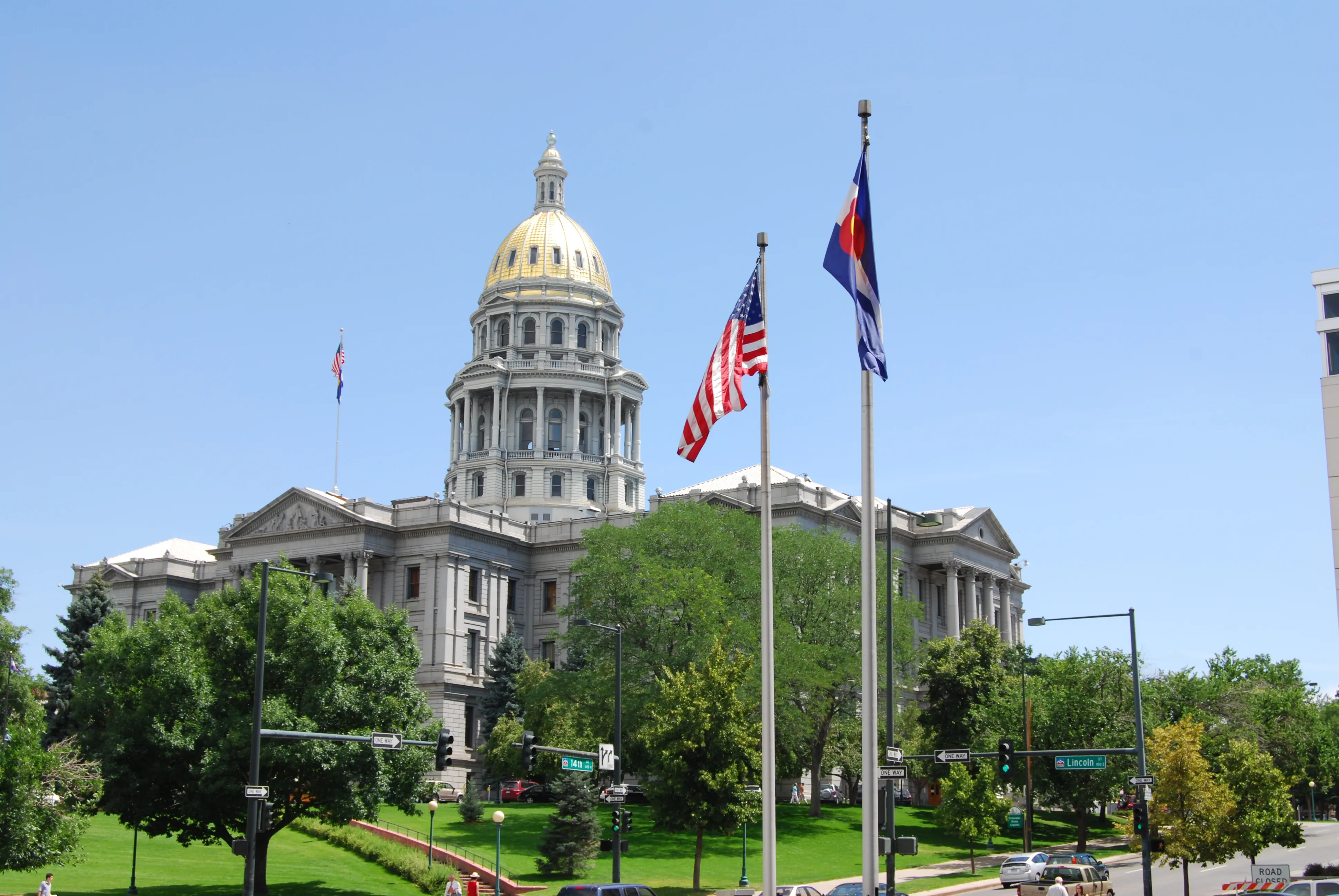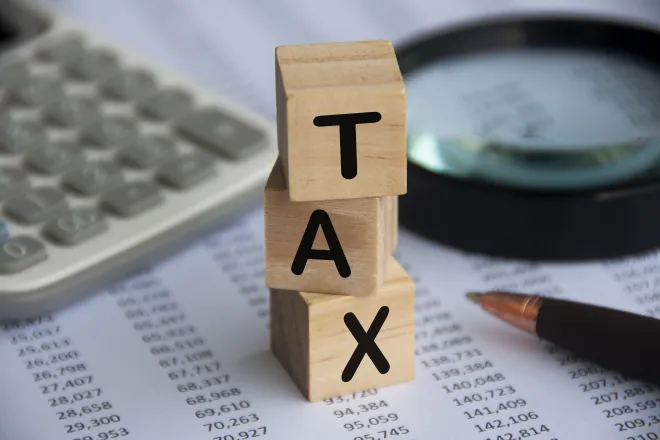
Denver turns to e-bike vouchers to help get cars, pollution off roads
Click play to listen to an abbreviated version of this article.
(Colorado News Connection) At 11:00 a.m. on the last Wednesday of February, Denver opened the first application window of the year for its e-bike rebate program, which offers residents upfront rebates of $300 to $1,400 for a battery-powered bicycle. Within three minutes, all of the vouchers for low and moderate income applicants had been claimed. By 11:08 a.m., the rebates for everyone else were gone too, and the portal closed.
Even in its third year, Denver's ambitious campaign to get residents to swap some of their driving for riding remains as popular as ever. "It's exciting that people are really interested in this technology," Mike Salisbury, the city's transportation energy lead, told Grist. "Every trip we can convert to an e-bike will be a big climate win."

Transportation is among the biggest sources, if not the biggest source, of a city's carbon emissions. To cut that footprint, officials often turn to costly, intensive transit projects and building out electric vehicle infrastructure. Denver is doing those things, but also propping up smaller forms of mobility. It spent more than $7.5 million in just two years on e-bike vouchers, supporting the purchase of nearly 8,000 of the battery-powered bicycles, which can zip along at up to 28 mph, power up hills, and carry passengers or cargo.
"We're just very bullish on e-bikes," said Salisbury. "They have this huge potential to replace vehicle trips."
The vouchers are saving some 170,000 miles in car trips per week and around 3,300 metric tons of greenhouse gas emissions annually, according to the city. Its Office of Climate Action, Sustainability, and Resiliency calls it "one of the most effective climate strategies that the city and county of Denver has deployed to date."
There are about 160 of these incentive programs across the U.S. and Canada, and while Denver wasn't the first to implement one, the size and success of its undertaking has attracted the attention of other governments and utilities. Congress is taking note as well: California Representative Jimmy Panetta reintroduced the federal Electric Bicycle Incentive Kickstart for the Environment Act, or E-BIKE Act, which would offer a 30 percent federal tax credit for e-bike purchases, last year.
Funded through a voter-approved $40 million Climate Protection Fund, which directs a portion of the city's sales tax toward decarbonization initiatives, the program offers income-based rebates that can be redeemed at designated bike shops. Providing the discount at the register helps those who might otherwise be unable to afford the upfront cost, which typically begins around $1,200 and can reach several thousand dollars.
Residents making less than 60 percent of the area median income of around $52,000 can get $1,200 for a standard e-bike and $1,400 for a cargo model (useful for carrying gear, making deliveries, or hauling kids). Moderate-income recipients receive between $700 or $900, and everyone else can get $300 or $500. Online applications open several times each year and vouchers are offered on a first-come, first-served basis.

© iStock - Toa55
The goal is to reduce emissions from the transportation sector, Denver's second-largest contributor of greenhouse gases, by targeting short vehicle trips. According to Salisbury, 44 percent of residents' trips are under 5 miles and most are under 10, feasible distances to travel on an e-bike.
"E-bikes aren't going to replace every single trip for every single person," he said. "But there's this huge potential to replace, especially in an urban environment, shorter distance trips that someone is making by themselves. Or they can use an e-cargo bike to take their kids to school."
That's one of the many ways Jeff Gonzales, a marketing professional and father living near the University of Denver, uses the power-assisted bike that he bought two years ago with the help of a voucher.
At the time, Gonzales drove a customized Toyota Tacoma pickup. "It was awesome, but it was a gas guzzler," he told Grist. Gas was so expensive that he and his wife were trying to minimize their driving as much as possible. But their two toddlers were getting too heavy to tow with the family's bike trailer, affectionately called "the chariot." When an employee at his local bike shop mentioned the rebates for power-assisted bicycles, he decided to take one for a test ride.
"I was like, 'This is pretty cool,' and then I asked them, 'Can I hook the chariot behind it?' They said 'Absolutely.'" Gonzales sold his truck, applied for a voucher, and bought the bike. He began riding it to the grocery store, taking the kids to school, and even making the 24-mile round-trip commute to his office twice a week.
"That first summer we had it, I think there were times that we didn't get in the car for about two weeks at a time," he said.
In a 2023 survey of voucher recipients, 43 percent of respondents cited commuting as their primary reason for getting an e-bike, and 84 percent said the machines replaced at least one vehicle trip per week. The city estimates that recipients are eliminating a weekly average of 21 miles in their cars.
Commuting on two wheels often allows riders to avoid traffic or take more direct routes than those offered by public transit. "People are sharing feedback with us on how it's enabled them to get to their job much faster, easier, at a much lower cost, without having to make two or three transit transfers to get to a place," said Salisbury.
Gonzales said he often finds biking to work quicker, but even when the ride doesn't save time, it's more enjoyable. "It sucks to sit in traffic," he said. "I'd rather be moving on a bike, and if I get tired, I can increase the power level, but I'm still moving."
The clean energy nonprofit RMI found that if the country's 10 most populous cities shifted a quarter of all short vehicle trips to e-bike rides, they could save 4.2 million barrels of oil and 1.8 million metric tons of CO2 in one year. That's the equivalent of taking four natural gas plants offline. As an added bonus, those riders also would save a combined total of $91 million per month in avoided fuel and vehicle maintenance costs, according to RMI.
But a recent study from Valdosta State University and Portland State University questions the cost effectiveness of achieving greenhouse gas emissions this way. "Even when e-bike incentive programs are designed cost-effectively," the authors concluded, "the costs per ton of CO2 reduced still far exceed those of alternatives or reasonable social costs of GHG emissions." A rebate program can still be beneficial, the study concludes, but may need to be justified through its additional benefits, like promoting exercise and relieving traffic congestion.
Salisbury said the report's critique overlooks how cities must tackle emissions in multiple ways. "There are lots of other things the city is working on, like building bus rapid transit and other infrastructure, but those take a long time," he said. "If we want to see reductions as soon as possible, we need to look at programs that can contribute to that right away."
He also pointed out that increasing access to e-bikes takes specific aim at one of the city's most difficult sectors to decarbonize. "Yes, it's cheaper to invest in a solar array, but that's not going to do anything for transportation emissions."
That's not to say that getting residents to swap four wheels for two is as simple as doling out a voucher. E-bikes require infrastructure, including bike lanes that can accommodate both motorized and analog riders, as well as places to charge and safely store bikes.
In the past five years, the city has added 137 miles of "high-comfort" bike lanes. Last month, it launched the Denver Mobility Incentive Program, offering grants to nonprofits and other organizations to install bike storage lockers, places to plug in, and even set up e-bike libraries where residents can borrow rides for free.
"It's all part of an ecosystem," said Salisbury. "Dropping 8,000 e-bikes on the road would be much less effective if we didn't have that co-developed infrastructure."
Gonzales uses that infrastructure when he has to cut through busy downtown Denver to reach his office. "About 90 percent of the time I'm on protected bike lanes," he said. "It makes me feel a lot more comfortable about biking 12 miles across town."
The city has also had to grapple with how to ensure that all residents can access the program. While more than 44 percent of the vouchers have gone to low-income applicants, the first-come, first-served application process has been criticized for favoring people with the time and computer access to log on as soon as the portal opens. And so far, the racial demographics of the recipients has not proven reflective of the city's population. In 2023, only 8 percent of survey respondents were Latino and 3 percent were Black, while Denver's population is 29 percent Latino and almost 9 percent Black. Despite offering up to $1,400 for adaptive bikes, the program has only distributed about 20 so far.
In response, Denver has worked with community-based organizations to funnel rebates directly to people who might not know about or be able to apply for them. It plans to distribute 600 vouchers through such groups this year.
The people least able to access the program may also be the ones who would put it to the most use. Survey results have indicated that applicants who received vouchers through community organizations are replacing 80 percent more vehicle miles than standard-voucher recipients.
This also marks the first year that Denver will offer a specific rebate amount for moderate-income applicants, an attempt to address the "missing middle" of people who earn closer to the city's median income but need a bit more help to afford a ride.
What the city will continue to struggle with this year is a demand for all levels of vouchers that far exceeds supply. The next round of applications will open on April 30.
One of those applications might come from the Gonzales family. With a third baby now in tow, they're thinking of getting a second power-assisted bike to transport the whole family. "When the little man gets bigger, we'd probably get another," said Gonzales, especially if the city is still offering vouchers. "They're not the cheapest things in the world, so the rebate program certainly helps."
Gabriela Aoun Angueira wrote this article for Grist.

















